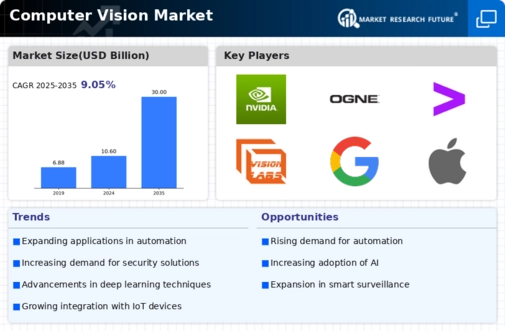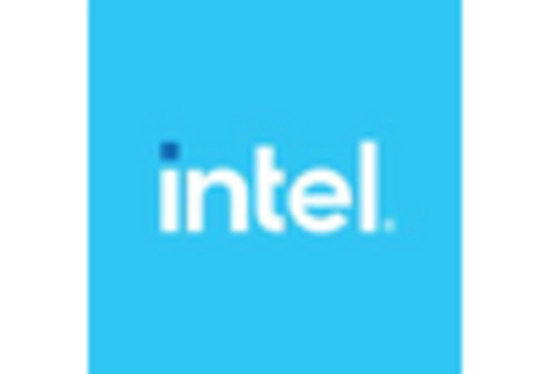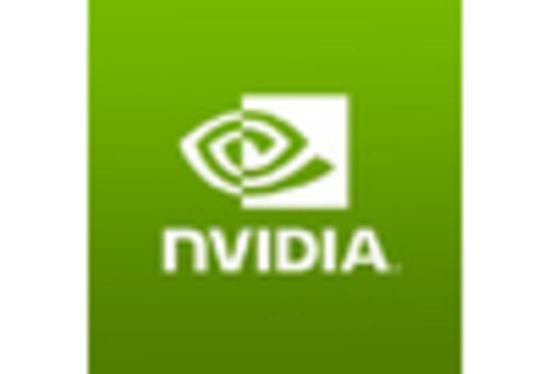Face Recognition
Object Detection
Image Classification
Motion Analysis
Medical Imaging
Deep Learning
Machine Learning
Image Processing
3D Vision
Image Recognition
Healthcare
Automotive
Retail
Security
Manufacturing
Cloud-Based
On-Premises
Edge Computing
North America
Europe
South America
Asia Pacific
Middle East and Africa
North America Outlook (USD Billion, 2019-2035)
North America Computer Vision Market by Application Type
Face Recognition
Object Detection
Image Classification
Motion Analysis
Medical Imaging
North America Computer Vision Market by Technology Type
Deep Learning
Machine Learning
Image Processing
3D Vision
Image Recognition
North America Computer Vision Market by End Use Type
Healthcare
Automotive
Retail
Security
Manufacturing
North America Computer Vision Market by Deployment Mode Type
Cloud-Based
On-Premises
Edge Computing
North America Computer Vision Market by Regional Type
US
Canada
US Outlook (USD Billion, 2019-2035)
US Computer Vision Market by Application Type
Face Recognition
Object Detection
Image Classification
Motion Analysis
Medical Imaging
US Computer Vision Market by Technology Type
Deep Learning
Machine Learning
Image Processing
3D Vision
Image Recognition
US Computer Vision Market by End Use Type
Healthcare
Automotive
Retail
Security
Manufacturing
US Computer Vision Market by Deployment Mode Type
Cloud-Based
On-Premises
Edge Computing
CANADA Outlook (USD Billion, 2019-2035)
CANADA Computer Vision Market by Application Type
Face Recognition
Object Detection
Image Classification
Motion Analysis
Medical Imaging
CANADA Computer Vision Market by Technology Type
Deep Learning
Machine Learning
Image Processing
3D Vision
Image Recognition
CANADA Computer Vision Market by End Use Type
Healthcare
Automotive
Retail
Security
Manufacturing
CANADA Computer Vision Market by Deployment Mode Type
Cloud-Based
On-Premises
Edge Computing
Europe Outlook (USD Billion, 2019-2035)
Europe Computer Vision Market by Application Type
Face Recognition
Object Detection
Image Classification
Motion Analysis
Medical Imaging
Europe Computer Vision Market by Technology Type
Deep Learning
Machine Learning
Image Processing
3D Vision
Image Recognition
Europe Computer Vision Market by End Use Type
Healthcare
Automotive
Retail
Security
Manufacturing
Europe Computer Vision Market by Deployment Mode Type
Cloud-Based
On-Premises
Edge Computing
Europe Computer Vision Market by Regional Type
Germany
UK
France
Russia
Italy
Spain
Rest of Europe
GERMANY Outlook (USD Billion, 2019-2035)
GERMANY Computer Vision Market by Application Type
Face Recognition
Object Detection
Image Classification
Motion Analysis
Medical Imaging
GERMANY Computer Vision Market by Technology Type
Deep Learning
Machine Learning
Image Processing
3D Vision
Image Recognition
GERMANY Computer Vision Market by End Use Type
Healthcare
Automotive
Retail
Security
Manufacturing
GERMANY Computer Vision Market by Deployment Mode Type
Cloud-Based
On-Premises
Edge Computing
UK Outlook (USD Billion, 2019-2035)
UK Computer Vision Market by Application Type
Face Recognition
Object Detection
Image Classification
Motion Analysis
Medical Imaging
UK Computer Vision Market by Technology Type
Deep Learning
Machine Learning
Image Processing
3D Vision
Image Recognition
UK Computer Vision Market by End Use Type
Healthcare
Automotive
Retail
Security
Manufacturing
UK Computer Vision Market by Deployment Mode Type
Cloud-Based
On-Premises
Edge Computing
FRANCE Outlook (USD Billion, 2019-2035)
FRANCE Computer Vision Market by Application Type
Face Recognition
Object Detection
Image Classification
Motion Analysis
Medical Imaging
FRANCE Computer Vision Market by Technology Type
Deep Learning
Machine Learning
Image Processing
3D Vision
Image Recognition
FRANCE Computer Vision Market by End Use Type
Healthcare
Automotive
Retail
Security
Manufacturing
FRANCE Computer Vision Market by Deployment Mode Type
Cloud-Based
On-Premises
Edge Computing
RUSSIA Outlook (USD Billion, 2019-2035)
RUSSIA Computer Vision Market by Application Type
Face Recognition
Object Detection
Image Classification
Motion Analysis
Medical Imaging
RUSSIA Computer Vision Market by Technology Type
Deep Learning
Machine Learning
Image Processing
3D Vision
Image Recognition
RUSSIA Computer Vision Market by End Use Type
Healthcare
Automotive
Retail
Security
Manufacturing
RUSSIA Computer Vision Market by Deployment Mode Type
Cloud-Based
On-Premises
Edge Computing
ITALY Outlook (USD Billion, 2019-2035)
ITALY Computer Vision Market by Application Type
Face Recognition
Object Detection
Image Classification
Motion Analysis
Medical Imaging
ITALY Computer Vision Market by Technology Type
Deep Learning
Machine Learning
Image Processing
3D Vision
Image Recognition
ITALY Computer Vision Market by End Use Type
Healthcare
Automotive
Retail
Security
Manufacturing
ITALY Computer Vision Market by Deployment Mode Type
Cloud-Based
On-Premises
Edge Computing
SPAIN Outlook (USD Billion, 2019-2035)
SPAIN Computer Vision Market by Application Type
Face Recognition
Object Detection
Image Classification
Motion Analysis
Medical Imaging
SPAIN Computer Vision Market by Technology Type
Deep Learning
Machine Learning
Image Processing
3D Vision
Image Recognition
SPAIN Computer Vision Market by End Use Type
Healthcare
Automotive
Retail
Security
Manufacturing
SPAIN Computer Vision Market by Deployment Mode Type
Cloud-Based
On-Premises
Edge Computing
REST OF EUROPE Outlook (USD Billion, 2019-2035)
REST OF EUROPE Computer Vision Market by Application Type
Face Recognition
Object Detection
Image Classification
Motion Analysis
Medical Imaging
REST OF EUROPE Computer Vision Market by Technology Type
Deep Learning
Machine Learning
Image Processing
3D Vision
Image Recognition
REST OF EUROPE Computer Vision Market by End Use Type
Healthcare
Automotive
Retail
Security
Manufacturing
REST OF EUROPE Computer Vision Market by Deployment Mode Type
Cloud-Based
On-Premises
Edge Computing
APAC Outlook (USD Billion, 2019-2035)
APAC Computer Vision Market by Application Type
Face Recognition
Object Detection
Image Classification
Motion Analysis
Medical Imaging
APAC Computer Vision Market by Technology Type
Deep Learning
Machine Learning
Image Processing
3D Vision
Image Recognition
APAC Computer Vision Market by End Use Type
Healthcare
Automotive
Retail
Security
Manufacturing
APAC Computer Vision Market by Deployment Mode Type
Cloud-Based
On-Premises
Edge Computing
APAC Computer Vision Market by Regional Type
China
India
Japan
South Korea
Malaysia
Thailand
Indonesia
Rest of APAC
CHINA Outlook (USD Billion, 2019-2035)
CHINA Computer Vision Market by Application Type
Face Recognition
Object Detection
Image Classification
Motion Analysis
Medical Imaging
CHINA Computer Vision Market by Technology Type
Deep Learning
Machine Learning
Image Processing
3D Vision
Image Recognition
CHINA Computer Vision Market by End Use Type
Healthcare
Automotive
Retail
Security
Manufacturing
CHINA Computer Vision Market by Deployment Mode Type
Cloud-Based
On-Premises
Edge Computing
INDIA Outlook (USD Billion, 2019-2035)
INDIA Computer Vision Market by Application Type
Face Recognition
Object Detection
Image Classification
Motion Analysis
Medical Imaging
INDIA Computer Vision Market by Technology Type
Deep Learning
Machine Learning
Image Processing
3D Vision
Image Recognition
INDIA Computer Vision Market by End Use Type
Healthcare
Automotive
Retail
Security
Manufacturing
INDIA Computer Vision Market by Deployment Mode Type
Cloud-Based
On-Premises
Edge Computing
JAPAN Outlook (USD Billion, 2019-2035)
JAPAN Computer Vision Market by Application Type
Face Recognition
Object Detection
Image Classification
Motion Analysis
Medical Imaging
JAPAN Computer Vision Market by Technology Type
Deep Learning
Machine Learning
Image Processing
3D Vision
Image Recognition
JAPAN Computer Vision Market by End Use Type
Healthcare
Automotive
Retail
Security
Manufacturing
JAPAN Computer Vision Market by Deployment Mode Type
Cloud-Based
On-Premises
Edge Computing
SOUTH KOREA Outlook (USD Billion, 2019-2035)
SOUTH KOREA Computer Vision Market by Application Type
Face Recognition
Object Detection
Image Classification
Motion Analysis
Medical Imaging
SOUTH KOREA Computer Vision Market by Technology Type
Deep Learning
Machine Learning
Image Processing
3D Vision
Image Recognition
SOUTH KOREA Computer Vision Market by End Use Type
Healthcare
Automotive
Retail
Security
Manufacturing
SOUTH KOREA Computer Vision Market by Deployment Mode Type
Cloud-Based
On-Premises
Edge Computing
MALAYSIA Outlook (USD Billion, 2019-2035)
MALAYSIA Computer Vision Market by Application Type
Face Recognition
Object Detection
Image Classification
Motion Analysis
Medical Imaging
MALAYSIA Computer Vision Market by Technology Type
Deep Learning
Machine Learning
Image Processing
3D Vision
Image Recognition
MALAYSIA Computer Vision Market by End Use Type
Healthcare
Automotive
Retail
Security
Manufacturing
MALAYSIA Computer Vision Market by Deployment Mode Type
Cloud-Based
On-Premises
Edge Computing
THAILAND Outlook (USD Billion, 2019-2035)
THAILAND Computer Vision Market by Application Type
Face Recognition
Object Detection
Image Classification
Motion Analysis
Medical Imaging
THAILAND Computer Vision Market by Technology Type
Deep Learning
Machine Learning
Image Processing
3D Vision
Image Recognition
THAILAND Computer Vision Market by End Use Type
Healthcare
Automotive
Retail
Security
Manufacturing
THAILAND Computer Vision Market by Deployment Mode Type
Cloud-Based
On-Premises
Edge Computing
INDONESIA Outlook (USD Billion, 2019-2035)
INDONESIA Computer Vision Market by Application Type
Face Recognition
Object Detection
Image Classification
Motion Analysis
Medical Imaging
INDONESIA Computer Vision Market by Technology Type
Deep Learning
Machine Learning
Image Processing
3D Vision
Image Recognition
INDONESIA Computer Vision Market by End Use Type
Healthcare
Automotive
Retail
Security
Manufacturing
INDONESIA Computer Vision Market by Deployment Mode Type
Cloud-Based
On-Premises
Edge Computing
REST OF APAC Outlook (USD Billion, 2019-2035)
REST OF APAC Computer Vision Market by Application Type
Face Recognition
Object Detection
Image Classification
Motion Analysis
Medical Imaging
REST OF APAC Computer Vision Market by Technology Type
Deep Learning
Machine Learning
Image Processing
3D Vision
Image Recognition
REST OF APAC Computer Vision Market by End Use Type
Healthcare
Automotive
Retail
Security
Manufacturing
REST OF APAC Computer Vision Market by Deployment Mode Type
Cloud-Based
On-Premises
Edge Computing
South America Outlook (USD Billion, 2019-2035)
South America Computer Vision Market by Application Type
Face Recognition
Object Detection
Image Classification
Motion Analysis
Medical Imaging
South America Computer Vision Market by Technology Type
Deep Learning
Machine Learning
Image Processing
3D Vision
Image Recognition
South America Computer Vision Market by End Use Type
Healthcare
Automotive
Retail
Security
Manufacturing
South America Computer Vision Market by Deployment Mode Type
Cloud-Based
On-Premises
Edge Computing
South America Computer Vision Market by Regional Type
Brazil
Mexico
Argentina
Rest of South America
BRAZIL Outlook (USD Billion, 2019-2035)
BRAZIL Computer Vision Market by Application Type
Face Recognition
Object Detection
Image Classification
Motion Analysis
Medical Imaging
BRAZIL Computer Vision Market by Technology Type
Deep Learning
Machine Learning
Image Processing
3D Vision
Image Recognition
BRAZIL Computer Vision Market by End Use Type
Healthcare
Automotive
Retail
Security
Manufacturing
BRAZIL Computer Vision Market by Deployment Mode Type
Cloud-Based
On-Premises
Edge Computing
MEXICO Outlook (USD Billion, 2019-2035)
MEXICO Computer Vision Market by Application Type
Face Recognition
Object Detection
Image Classification
Motion Analysis
Medical Imaging
MEXICO Computer Vision Market by Technology Type
Deep Learning
Machine Learning
Image Processing
3D Vision
Image Recognition
MEXICO Computer Vision Market by End Use Type
Healthcare
Automotive
Retail
Security
Manufacturing
MEXICO Computer Vision Market by Deployment Mode Type
Cloud-Based
On-Premises
Edge Computing
ARGENTINA Outlook (USD Billion, 2019-2035)
ARGENTINA Computer Vision Market by Application Type
Face Recognition
Object Detection
Image Classification
Motion Analysis
Medical Imaging
ARGENTINA Computer Vision Market by Technology Type
Deep Learning
Machine Learning
Image Processing
3D Vision
Image Recognition
ARGENTINA Computer Vision Market by End Use Type
Healthcare
Automotive
Retail
Security
Manufacturing
ARGENTINA Computer Vision Market by Deployment Mode Type
Cloud-Based
On-Premises
Edge Computing
REST OF SOUTH AMERICA Outlook (USD Billion, 2019-2035)
REST OF SOUTH AMERICA Computer Vision Market by Application Type
Face Recognition
Object Detection
Image Classification
Motion Analysis
Medical Imaging
REST OF SOUTH AMERICA Computer Vision Market by Technology Type
Deep Learning
Machine Learning
Image Processing
3D Vision
Image Recognition
REST OF SOUTH AMERICA Computer Vision Market by End Use Type
Healthcare
Automotive
Retail
Security
Manufacturing
REST OF SOUTH AMERICA Computer Vision Market by Deployment Mode Type
Cloud-Based
On-Premises
Edge Computing
MEA Outlook (USD Billion, 2019-2035)
MEA Computer Vision Market by Application Type
Face Recognition
Object Detection
Image Classification
Motion Analysis
Medical Imaging
MEA Computer Vision Market by Technology Type
Deep Learning
Machine Learning
Image Processing
3D Vision
Image Recognition
MEA Computer Vision Market by End Use Type
Healthcare
Automotive
Retail
Security
Manufacturing
MEA Computer Vision Market by Deployment Mode Type
Cloud-Based
On-Premises
Edge Computing
MEA Computer Vision Market by Regional Type
GCC Countries
South Africa
Rest of MEA
GCC COUNTRIES Outlook (USD Billion, 2019-2035)
GCC COUNTRIES Computer Vision Market by Application Type
Face Recognition
Object Detection
Image Classification
Motion Analysis
Medical Imaging
GCC COUNTRIES Computer Vision Market by Technology Type
Deep Learning
Machine Learning
Image Processing
3D Vision
Image Recognition
GCC COUNTRIES Computer Vision Market by End Use Type
Healthcare
Automotive
Retail
Security
Manufacturing
GCC COUNTRIES Computer Vision Market by Deployment Mode Type
Cloud-Based
On-Premises
Edge Computing
SOUTH AFRICA Outlook (USD Billion, 2019-2035)
SOUTH AFRICA Computer Vision Market by Application Type
Face Recognition
Object Detection
Image Classification
Motion Analysis
Medical Imaging
SOUTH AFRICA Computer Vision Market by Technology Type
Deep Learning
Machine Learning
Image Processing
3D Vision
Image Recognition
SOUTH AFRICA Computer Vision Market by End Use Type
Healthcare
Automotive
Retail
Security
Manufacturing
SOUTH AFRICA Computer Vision Market by Deployment Mode Type
Cloud-Based
On-Premises
Edge Computing
REST OF MEA Outlook (USD Billion, 2019-2035)
REST OF MEA Computer Vision Market by Application Type
Face Recognition
Object Detection
Image Classification
Motion Analysis
Medical Imaging
REST OF MEA Computer Vision Market by Technology Type
Deep Learning
Machine Learning
Image Processing
3D Vision
Image Recognition
REST OF MEA Computer Vision Market by End Use Type
Healthcare
Automotive
Retail
Security
Manufacturing
REST OF MEA Computer Vision Market by Deployment Mode Type
Cloud-Based
On-Premises
Edge Computing









Leave a Comment